
by Editor | Apr 11, 2016 | Accomodations, Ecotourism
By Elena del Valle
Photos by Gary Cox

Camp Moremi, a luxury tented camp in Botswana, Southern Africa
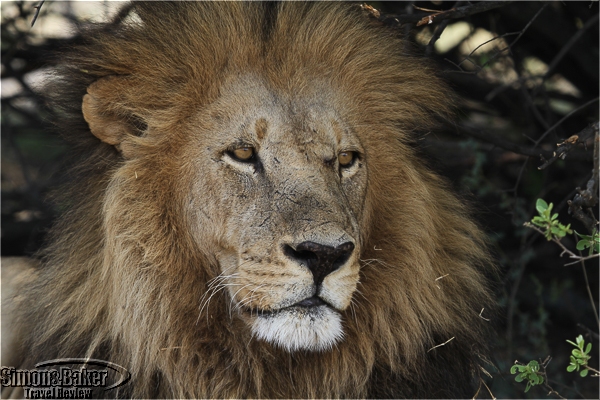
Our greeting committee was a coalition of lions.
During a recent multi-country safari itinerary we spent three nights at Camp Moremi (Desert & Delta Safaris, Private bag 310, Maun, Botswana, +267 6861243 and +267 6861418, Fax +267 6861791, http://www.desertdelta.com, camp.moremi@dds.co.bw), a luxury tented camp within Botswana’s Chobe Game Reserve in Southern Africa. To reach the property we flew on a small plane from Lerro LaTau, its sister Desert & Delta Safaris property on the Boteti River adjacent to the Makgadikgadi Pans. Our first impression driving from the landing strip through a mopane forest was of the vegetation and color contrast from the dry straw colored patches and scrawny plants of the Kalahari area to the south and the bushier greener area near camp.
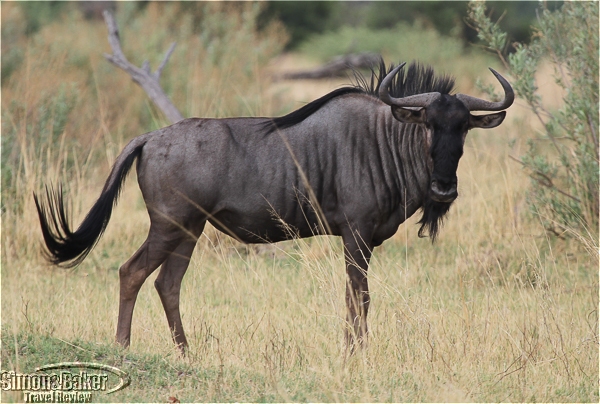
A wildebeest watched us briefly before running off into the bush
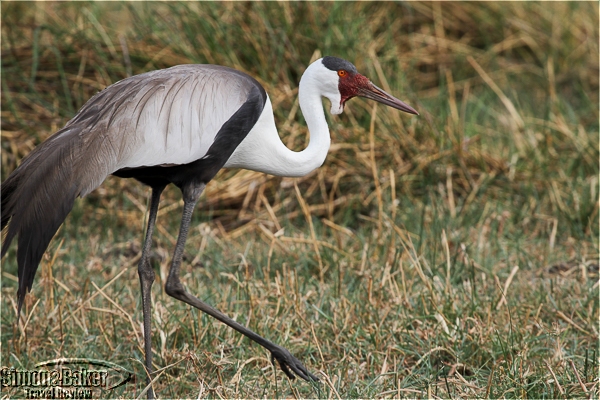
A wattled crane
Arriving at the camp’s central lawn we heard the cacophony cries of dozens of Burchell’s starlings calling in the midday heat in the tree canopy above us. The game viewing property overlooked the Xakanaka Lagoon to the west and the inland mopane forest and open grasslands to the east. During our twice daily game drives in the reserve on partly open vehicles we saw three of the Big Five and many birds, as well as a number of other fauna. Our guide also identified some flora. Since visits to the park were limited to daytime hours, in the mornings, we entered the park immediately after sunrise and in the afternoons we exited right before sunset. At night, we had to be escorted by a staff member from our tents to dinner and back in case we encountered animals within the camp.
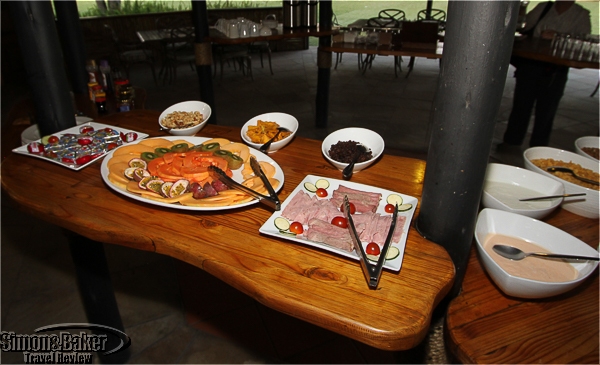
Our breakfast included a cold buffet.
Camp Moremi was established in 1984 and completely renovated in 2012. It had 12 luxury tents on a five hectare generator powered camp with 32 Setswana staff. Bruce Petty was the general manager. While we were there Thuso, Frank, Lydia, and Lettie shared management duties. The property, which had Ecotourism status from the Botswana Tourism Organisation, received a TripAdvisor 2015 Certificate of Excellence.
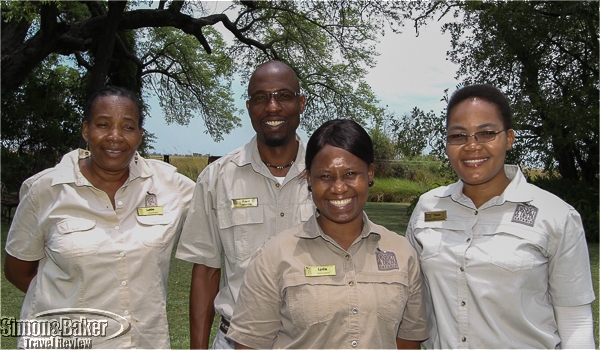
Thuso, Frank, Lydia, and Lettie managed Camp Moremi
Our accommodations consisted of 5 meter by 5 meter tents atop wood platforms set slightly above the bush. Each of our tents had four distinct areas: a spacious entry foyer with a writing desk and mirror; a bathroom with a walk in shower with hot and cold running water, and a flush toilet; a bedroom; and a covered bush facing deck.
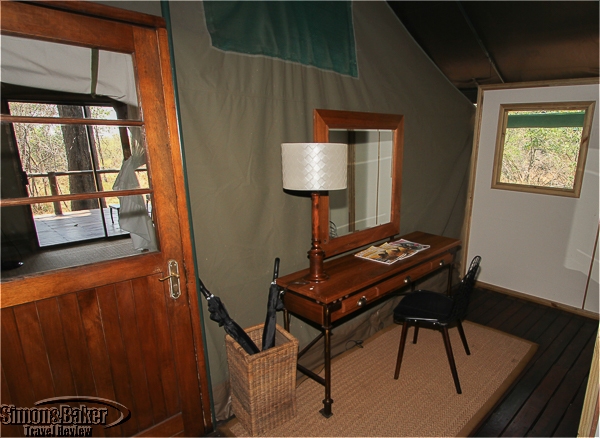
The entry sitting space with mirror, desk and chair.
At a previous Desert and Delta Safaris property the staff provided a metal container for each of us to fill up with bottled water from a common area cooler. This method was designed to cut back on the number of plastic bottles discarded. Because of the high temperatures (reaching 45 Celsius while we were there) the water in that container heated up soon after filling it up. Our ice buckets were replenished once a day in the morning, but the ice melted within minutes. Refilling our bottles also required queuing up at the single water cooler when everyone was preparing for departure and time was limited. The water chilled from the cooler became warm within minutes. Also, carrying the bottles from our rooms to refill them in the main building was inconvenient, especially during the rest period between activities when it was hot and uncomfortable everywhere and we sought water to lower our body temperature and became thirsty. Although we liked the conservation minded concept behind the refillable non thermos metallic bottles, in practice the idea did not work well at all.
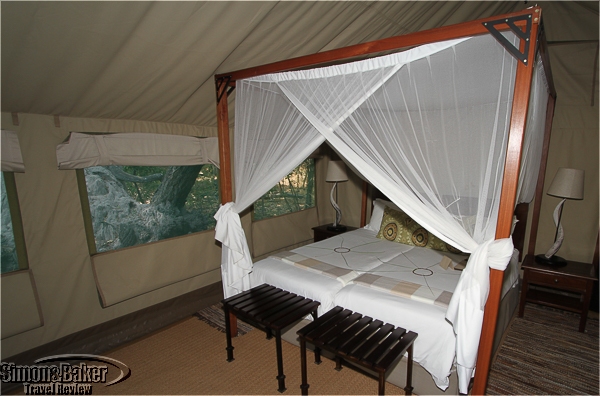
At night, the staff spread mosquito netting around the two single beds set next to each.

The bathroom in the tent had a bush view.
Meals and game drives were included in the nightly rates. Tent amenities included: two cotton bathrobes, Charlotte Rhys Refillable toiletries (conditioning shampoo, shower gel and body lotion), two umbrellas, insect repellent, insect spray, flashlight, and shower caps. There was no soap (only shower gel). There was a dining area with a bar and a library corner that included a popular computer for guest use with a very slow (1 megabyte, 1-100 kilobytes per second) connection, a curio shop, an elevated viewing deck facing the lagoon, and an outdoor pool.
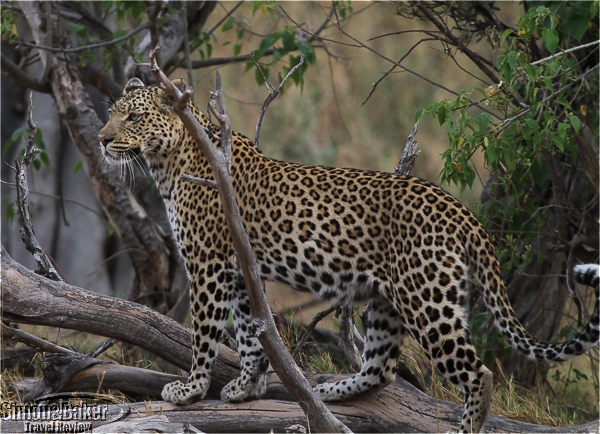
Our best leopard sighting in Botswana
During our summer visit, the 1.5 meter deep plunge pool deck was the most comfortable place in the property in the middle hours of the day between brunch and tea time. The pool area had eight cushioned lounge chairs with rolled up towels on every chair and two large umbrellas. The pool floor was slick, requiring care to avoid slipping. There was also a cooler with bottled beverages although it had no ice so the beverages were almost at ambient temperature.
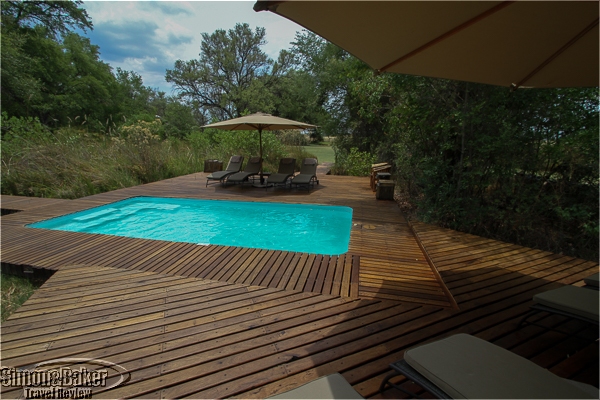
The pool was the place to find relief from the blistering heat
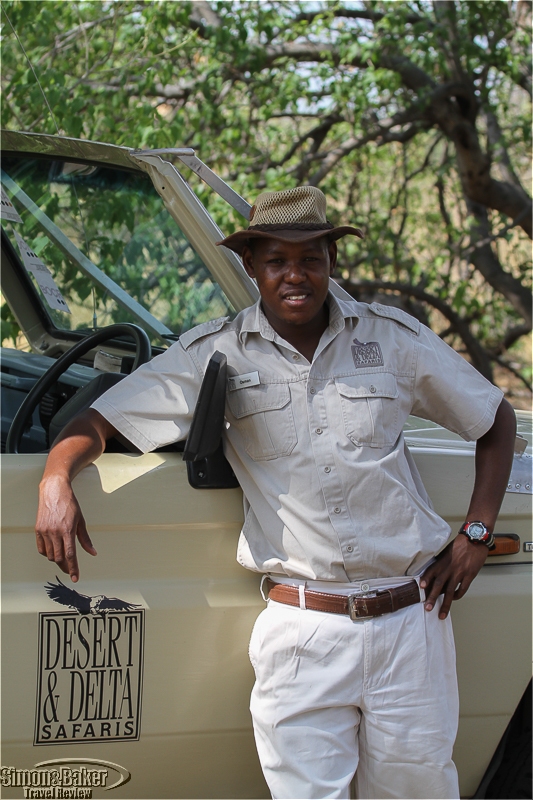
Our guide Osman in front of our safari vehicle
Our very bumpy game drives were aboard a canvas topped Toyota Landcruiser with three rows that could accommodate two passengers in each of the front rows and three in the rear row. Osman, our Setswana guide, had three years of experience. In his company we saw Kalahari apple-leaf, baobab, jackal-berry, leadwood, marula, sausage trees, blue water lily flowers and papyrus as well as baboon, bushbuck, elephants, giraffe, hippopotamus, brown hyena, lechwe, leopard, lion, banded mongoose, Selous mongoose, vervet monkey, reedbuck, sitatunga, South African ground squirrel, tsessebe, waterbuck warthog, wildebeest, and zebra. We also saw Nile crocodile, Nile monitor and Okavango hinged terrapin. He pointed out hippo tracks and mole rat holes.
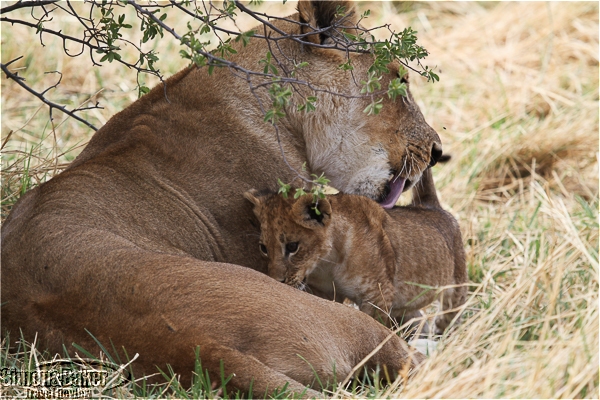
A mother lion and her cub

The entrance to our tents was lit at night.
Birds we saw or heard included: arrow-marked babbler, black-collared barbet, crested barbet, bateleur, Southern carmine bee-eater, swamp boubou, reed cormorant, wattled crane, African darter, fork-tailed drongo, white-faced duck, yellow-billed duck, cattle egret, great egret, little egret, slaty egret, African fish-eagle, go-away-bird, Egyptian goose, spur-winged goose, Southern ground-hornbill, grey heron, purple heron, squacco heron, red-billed hoopoe, African hoopoe, African grey hornbill, red-billed hornbill, glossy hornbill, pied kingfisher, woodland kingfisher, yellow-billed kite, blacksmith lapwing, crowned lapwing, Meyer’s parrot, Kittlitz’s plover, broad-billed roller, brown snake-eagle, red-billed spurfowl, Burchell’s starling, Cape glossy starling, black-winged stilt, African stonechat, saddle-billed stork, yellow-billed stork, barn swallow, water thick-knee, hammerkop, wattled crane and golden-tailed woodpecker.
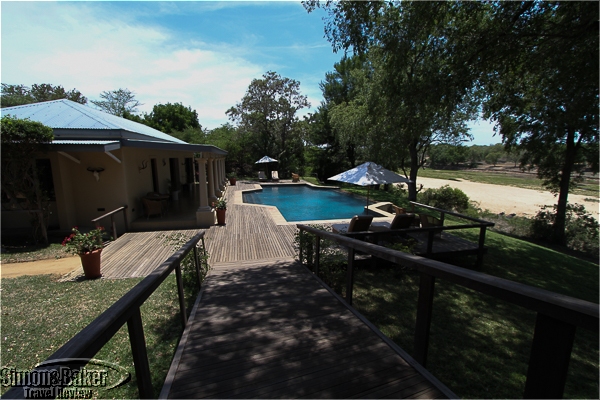
by Editor | Mar 7, 2016 | Accomodations, Ecotourism, Luxury Travel, New Articles
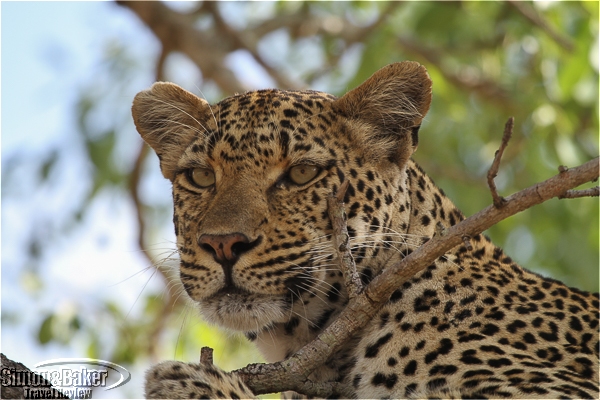
A leopard in a tree during a game drive at Rattray’s on MalaMala
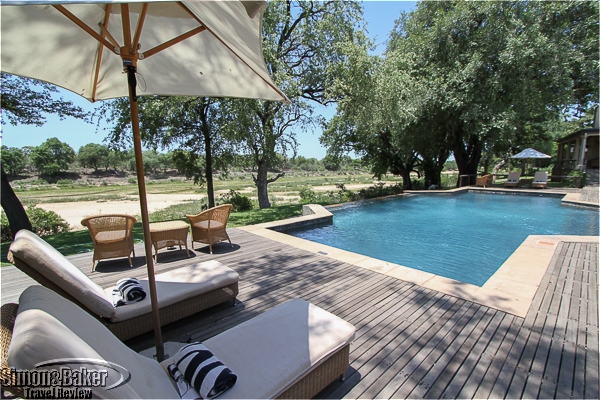
The pool at Ratttray’s had a view of the dry river bed
When on safari the repetitive cycle of daily game drives and copious meals can leave us tired without the healthful benefits of exercise. On our most recent itinerary featuring safari properties in Botswana, Namibia and South Africa two lodges stood out for their fitness and pool features. Both lodges, within the Sabi Sand Reserve, a private reserve adjacent to South Africa’s Kruger National Park, had private plunge pools in the rooms as well as a main area swimming pool large enough to swim short laps.
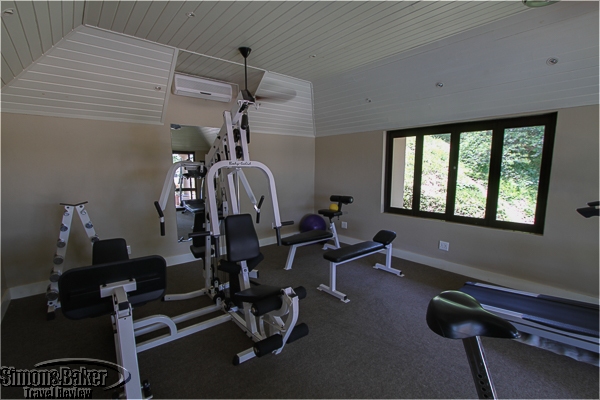
The exercise room at Rattray’s
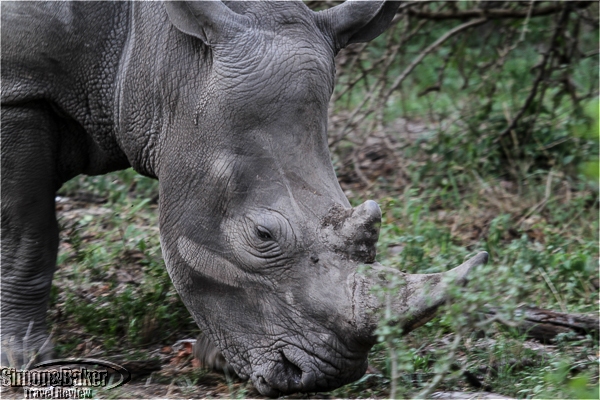
A white rhino during a game drive at Rattray’s
In the Mala Mala Reserve, Rattray’s on MalaMala had a dedicated fitness room for guests with exercise equipment and a few weights. Next to the fitness room there was a sauna. In front of the fitness room there was a swimming pool. Both had expansive views of the lawn and dry river bed. In addition, there were private plunge pools on the river facing deck of each spacious room.
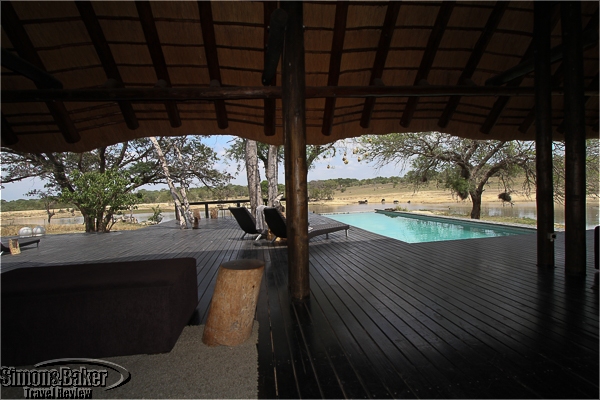
The main pool at Chitwa Chitwa Private Game Lodge faced a dam
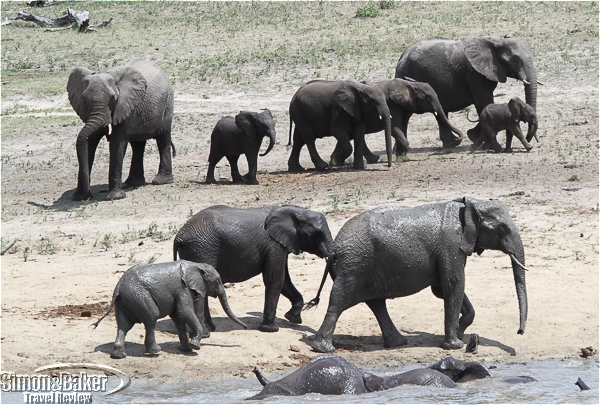
From the pool deck we observed elephants visiting the dam
Chitwa Chitwa Private Game Lodge, in the northern end of Sabi Sand Reserve, also had a dedicated workout room with electric exercise machines. The art filled sunlit room with glass walls was adjacent to the property’s dedicated spa treatment room. Guest rooms had private decks with bush and dam views as well as plunge pools. In the main area, there was a rimless swimming pool facing the property dam.
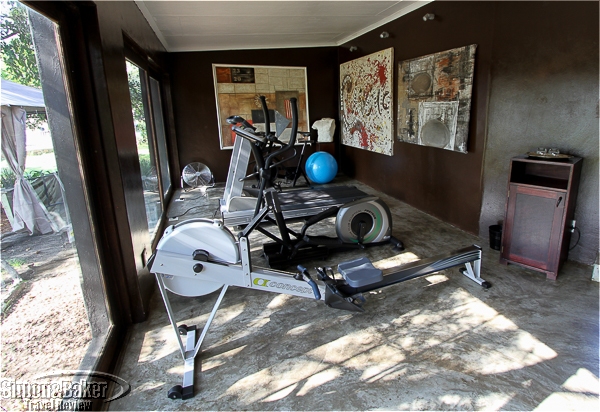
The exercise room at Chitwa Chitwa
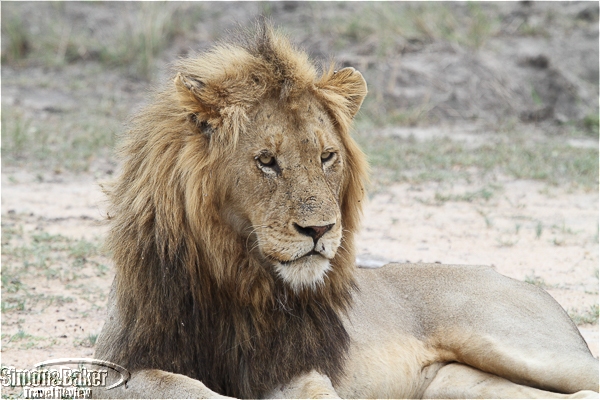
A lion seen during a game drive at Chitwa Chitwa
by Editor | Dec 28, 2015 | Books, Ecotourism
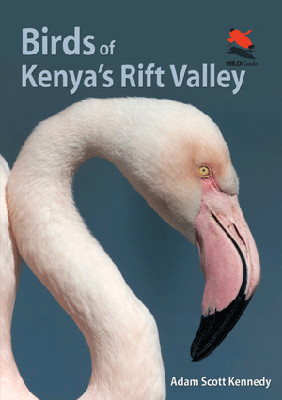
Birds of Kenya
Photo: Princeton Press
The thousands of flamingos on Lake Nakuru may be perhaps the most famous of bird sightings in Kenya’s Rift Valley.
There are many bird other species in that area, which includes four national parks: Lake Nakuru, Lake Bogoria, Mount Longonot, and Hell’s Gate. Birds of Kenya’s Rift Valley (Princeton University Press, $29.95), a 256-page softcover book by Adam Scott Kennedy published in 2014, features the 320 bird species he believes travelers are most likely to encounter on safari in the region, which runs from Lake Baringo in the north to Lake Magadi in the south.
In the book, there are 500 color photos, most by the author, as well as non technical information on the ecology of the area and bird behaviors by species. It is divided into seven sections: Birds of Lake and Marsh; Up In the Air; Birds of Prey, Birds of Grassland and Open Areas; Birds of Wood, Scrub and Garden; and Night Birds.
Scott Kennedy has served as principal leader on birding holidays in Africa, South America, Europe, and New Zealand. He and his wife, Vicki, operate as private safari guides, specializing in photographic and wildlife safaris in East Africa. He is the author of Birds of the Masai Mara (see New Masai Mara bird book available).
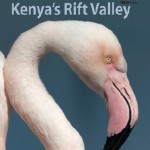
Click to buy Birds of Kenya’s Rift Valley (WILDGuides)
by Editor | Aug 10, 2015 | Ecotourism, New Articles
By Elena del Valle and photos by Gary Cox
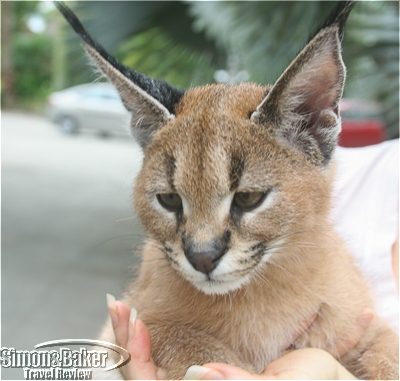
Freya, a caracal lynx
As I stood near a lion themed water fountain in a subtropical garden at the Zoological Wildlife Foundation in the southwestern suburbs of Miami, Florida holding Freya, a relaxed caracal lynx, an African khaki colored wild cat with pointy ears, I marveled and took a mental snap shot of the special moment. Never in the many safari drives and walks I have been fortunate enough to enjoy over the years had I come close to the elusive bush animal. Freya allowed me to pet its head and back. I was surprised at how soft the fur felt and how comfortable Freya was settled in my arms.
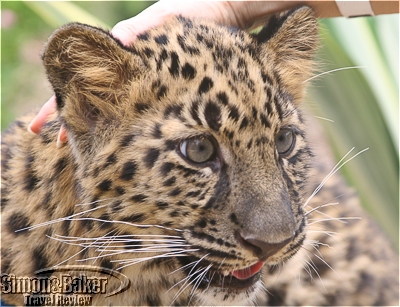
Vadim, a rare amur leopard
Sure, the caracal’s attention span was fleeting. It turned left toward a group of visitors near the monkey cages and right as the sounds of nearby construction drew its attention. Yet it was calm, allowing me to savor the experience while my partner struggled to photograph it because while its body remained immobile its head swiveled around constantly. It was curious and distracted, making it difficult to capture even a single clear image.
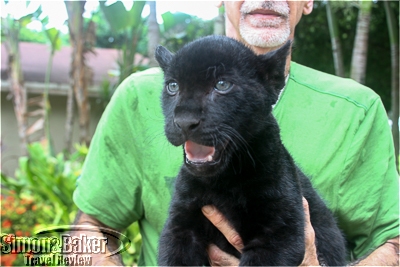
Mario Trabaue holding Onyx, a restless black jaguar
Next, we had a chance to hold Onyx, a young black jaguar. Despite the clouded midday sky we could see the muted rosettes on his black coat. They were stunning. Freya seemed downright angelic in comparison to the gorgeous jaguar who would not be still, not even in the arms of its expert handler. After a few moments of intense and futile wrangling I passed Onyx back to him. He had little more luck than I did. Eventually it was my travel partner’s turn to hold the cat. When for an instant Onyx calmed down I lifted the camera to take photos until my partner yelped. The reason the cat had seemed less agitated was because it was defecating and the excrement landed on his arm. The incident did nothing to dampen our enthusiasm. He cleaned his arm as best as he could with the chilled iced tea bottle we had at hand while we watched Onyx leave in the company of its owners, Maria C. Tabraue and Mario Trabaue, who had come to greet us during our Zoological Wildlife Foundation Private Tour with a primate and feline interaction session.
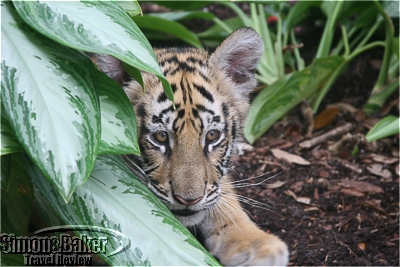
Sarabi, a playful tiger cub
Stephen Gregorio, our friendly guide and the Foundation’s zookeeper, had Vadim, a rare amur leopard, on a leash a few feet away from us. They had been standing there during our interaction with Onyx. Vadim too returned to his enclosure shortly after Onyx. In the interim, we awaited the arrival of Sarabi, an adorable tiger cub. We could not get enough of him. He acted like the aloof celebrity he was, gently biting his handler’s pants, pouncing on plants, and stalking invisible prey. We also spent quality time with Amorette, a capuchin monkey, and after her Chung, a gibbon. Curious and playful she arrived with a stuffed companion and was relatively calm in my arms. Chung, on the other hand, wouldn’t hold still for a moment, and was desperate to flee and explore on his own.

Stephen Gregorio, zookeeper at the Foundation, and Amorette, a capuchin monkey
Many of the non human inhabitants of the Foundation were born there (50 percent of the babies had been born and remained at the facility) or transferred from Zoological Association of America accredited facilities. Some were rescues from people who could no longer house them while others had been seized from owners without permits or wildlife violators. Still others had been abandoned, injured or brought for rehabilitation. Whenever possible the Foundation released rehabilitated animals, a spokesperson explained.
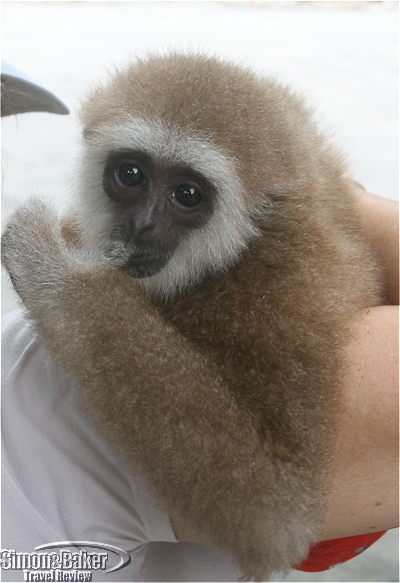
Chung, a gibbon, wanted to explore
The five-acre facility welcomed approximately 20,000 visitors per year. While we awaited our tour guide in the check-in arrival area we heard several foreign languages. It was no surprise since slightly more than half of the visitors were from out of the state or the country. I imagined the intimate wildlife experience drew many of the tourists from near, like us, and far away. According to a 2014 article by Sharon Guynup in NationalGeographic.com only 3,000 tigers may remain in the wild.
According to WildLifeConservationSociety.com only 25 to 40 amur leopards remain in the wild. During our visit to the Foundation we saw a tiger and an amur leopard. They were clean and appeared to be well looked after by the staff. While my preference remains to see wildlife in its natural habitat, in those cases where the animals may no longer survive and thrive in the wild a captive environment may be the only alternative. The Foundation provided a home for its animal residents and an opportunity for visitors to support the upkeep of the animals and at the same time visit them. It was a memorable experience worth repeating.
by Editor | Jul 27, 2015 | Ecotourism, Luxury Travel, New Articles
Article and photos by Josette King
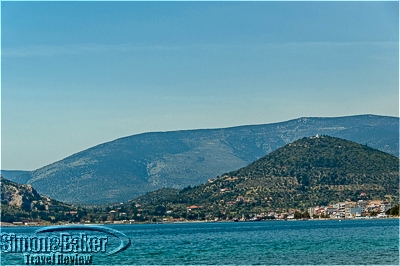
The Gulf of Corinth
I thought I knew Greece. I had visited a couple of its legendary islands and snorkeled in the crystalline waters of its rocky coves. I had stayed in Athens long enough to explore most of its nearby ancient ruins. I had enjoyed the taverna food and the street musicians playing their ornate nine-string bouzouki. And I had learned to stay clear of ouzo, the fiery local brew. So, yes I thought I knew Greece. Until I came across an eight-day Tripology Adventures itinerary from Athens to the Pindus Mountains with overnight stops in Delphi, Ano Chora, Karpenisi, Kalampaka and back to Athens.
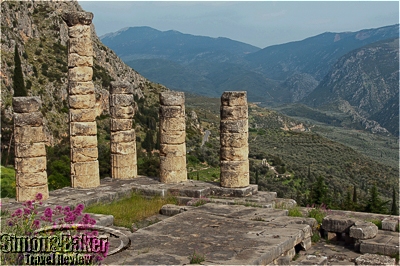
Columns of the temple of Apollo in Delphi
Tripology is an adventure travel company that has been leading self-drive caravans of all-wheel drive vehicles into remote history-rich areas of the planet for over two decades. The Pindus Mountain Range, the vast backbone of peaks, valleys and gorges that traverses the Greek mainland from the northwest to the southeast definitely fit that profile. It is covered with forests so impenetrable that its central region, the Agrafa (Greek for unchartered), succeeded in maintaining its autonomy throughout the four centuries of Ottoman occupation of the country, becoming a refuge for the fiercely independent souls who wanted to escape the oppressors. That wild, sparsely inhabited region has remained relatively pristine to this day. Most of the roads that wind their way up and down its steep slopes are still unpaved. That was a unique opportunity to venture on terrains that I knew better than to attempt on my own and explore a Greece I hadn’t realized still existed.

Statuary from the Delphi Archeological site now on display in its museum
Our five-vehicle convoy left Athens on a sunny spring morning, four late model 4 x 4 vehicles packed with eager adventurers, 14 of us in all, following the lead land cruiser with our guide, Yoav Barashi, a seven year veteran of Tripology tours in the area. Our lead driver Nikos Manolis, an expert all terrains driver, was also a noted figure in the Greek rally community. The highlights of the first day, a relaxed seaside lunch on the Gulf of Corinth and a privately guided tour of the archeological site of Delphi, were a pleasant nod to familiar Greece, and an ideal opportunity for us to get acquainted with our traveling companions and our vehicles.

Tiny roadside shrines were a frequent sight
The next morning, the roller-coaster ride that was to become the norm for our entire 1,200 kilometer trip began in earnest as we negotiated Bauxite Way. The 24 kilometer (15 mile) uphill strip of gravel and tight turns is one of the best known stages of the Acropolis Rally of Greece, named after the nearby aluminum ore mine and the prevalent red dust. After the exhilarating driving experience followed by a break at the shaded terrace of a village taverna, we were on our way again. That time we climbed up a rough unpaved trail that hugged the rock face and curved incessantly upon itself on our way to a mountaintop picnic. Our lunch scenery was a jaw-dropping view of densely forested canyons and craggy peaks. Then after an equally tortuous descent we ended up at a rustic village inn for the night.

Lake Mornos
Day after day, as we drove deeper into the Pindus and entered the Agrafa area, the mountains became higher, the canyon deeper and the trails hewed out of the rock more forbidding. Those dramatic vistas bursting with the colors of spring were a photographer’s paradise. Each turn revealed a better view of snow capped peaks, a turquoise lake sculpted by canyons in the shape of a giant octopus or a hill dotted with the purple blooms of Judas trees. Tiny roadside shrines were a frequent sight, presumably meant to petition for divine protection on behalf of intrepid travelers or offer thanks for road catastrophes avoided as much as to mark the spot of one that had been.
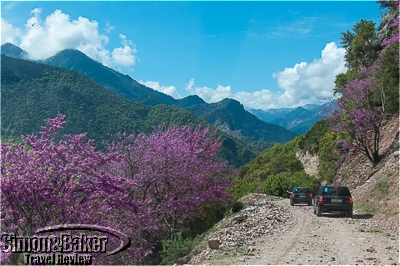
The mountain roads were lined with Judas trees in full bloom
We could drive for hours without seeing a sign of human life, much less another car. Then a shepherd with his flock of long haired sheep appeared, or a herd of goats plundering the high grass at the edge of road or beekeepers tending their hives. One more bend in the road would reveal a village of sturdy stone houses stacked against the mountain, and blending into the rock. We would stop in the central platia, the village square at the heart of every Greek village bookended by the ubiquitous taverna on one side and the village church on the other. Even the smallest of churches was a treasure trove of gilded icons and byzantine style frescoes.

Cemetery on the shore of Lake Kremaston
Our guide Yoav was remarkable for his extensive knowledge of the region and also for his passionate interest in it, which he shared over our two way radio channel. He brought places and events into human context, shedding light on a vibrant and often tragic history that is little more than a footnote in western history books. He was equally knowledgeable of the tales of Greek mythology, mimicking to great effect the foibles of Zeus, Apollo, Hermes and even Aphrodite or Psyche. Had my high school history teacher possessed a fraction of his story telling talent, I might have been an ancient Greece scholar today.
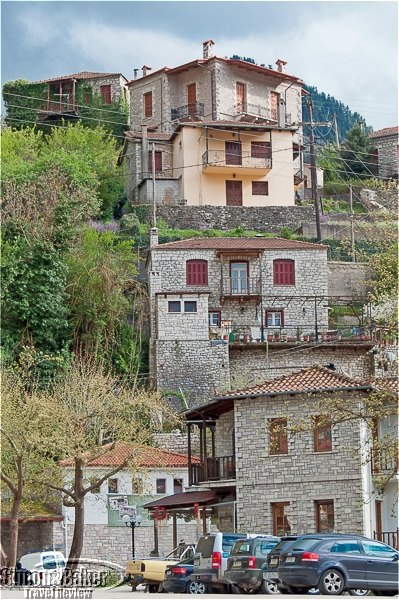
Villages were stacked against the hillsides
Do I know Greece now? I do, a little better at least. But more importantly, thanks to this road journey, I fell in love with the country. I now yearn to return at the first opportunity. And best of all, I so enjoyed the Tripology Adventures way of exploring new horizons that I am already searching their destinations for my next road adventure.
by Editor | Feb 16, 2015 | Accomodations, Ecotourism
By Elena del Valle
Photos by Gary Cox
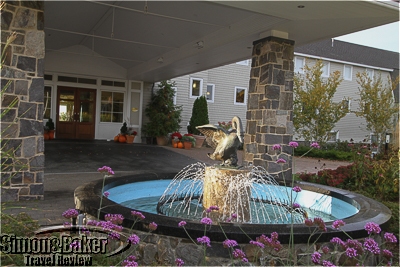
The entrance to the Inn by the Sea
During a fall visit to Maine we spent three nights at the Inn by the Sea, a boutique 61-room beach facing hotel in Cape Elizabeth south of Portland. We liked the inn’s location in a quiet residential area close enough to Portland for visits yet distant from city traffic and noise. We loved our well appointed two-bedroom suite with wonderful fall coastal views. We enjoyed the lovingly tended manicured grounds and Spa at Inn by the Sea in particular.
I liked the spa’s use of natural marine products like sea salt, algae and seaweed, essential oils and coastal themed treatments. In addition, we appreciated the property’s approach to responsible tourism, blending luxury, service and an exceptional guest stay with sustainability, and minimizing the impact of hotel operations with eco friendly initiatives and local sourcing.
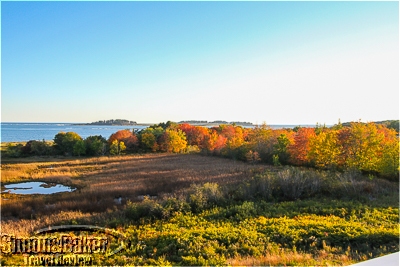
The fall colors in all their glory (click to enlarge)
One example was the Inn’s landscape designed to be attractive to guests and butterflies. Inn staff focused on local plants to create ever blooming gardens and a habitat for indigenous wildlife, earning the inn a Wildlife Habitat certification from the National Wildlife Federation. Indigenous nectar gardens and milkweed were specifically planted for endangered butterflies. During the growing season, the property offered classes on How to Plant for Wildlife, and as part of the Bug’s Life Garden Tours staff taught children about local ecosystems from an insect’s viewpoint. Monarch Watch, which registers properties that provide food and shelter for the endangered monarch butterflies as they migrate through North America, certified the Inn as a Butterfly Waystation.
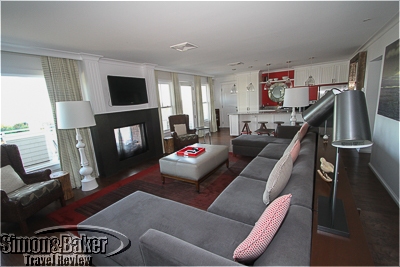
The living room with fireplace and kitchen of our two bedroom suite
Inn staff worked with seven local schools to provide educational programs throughout the year. In December, the Inn bought a school book from a school librarian’s list with every reservation.
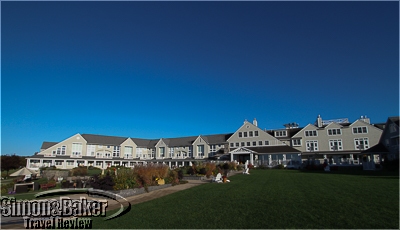
The spacious grounds viewed from the back of the hotel (click to enlarge)
At the hotel restaurant, Mitchell Kaldrovich, executive chef, emphasized local produce, meat and poultry from nearby farms and Gulf of Maine fresh underutilized seafood. Working with the Gulf of Maine Research Institute (GMRI), other Portland area chefs, and a handful of knowledgeable local fishermen, he identified abundant and delectable fish from the Gulf of Maine that were under appreciated and underutilized to offer guests. The program, Out of the Blue, was meant to bring attention to plentiful seafood available in the Gulf of Maine, get better dock prices for fishermen, and help preserve the diversity and health of the Gulf of Maine. The chef was a supporter of the Root to Stock movement. Food waste was composted for later use as landscaping compost for the Inn.
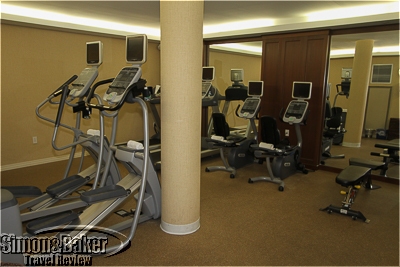
The workout room was downstairs in the spa.
The property had a Silver LEED and Maine DEP Environmental Leader Green Lodging certification thanks to the integration of solar panels, recycled sheet rock walls, recycled cork floors, recycled rubber floors in the cardio room, air to air heat exchangers, dual flush toilets, heating with bio fuels, preferred hybrid parking, sheet and towel reuse programs and purchased renewable electricity.

There were plantings of vegetables and flowers (click to enlarge).
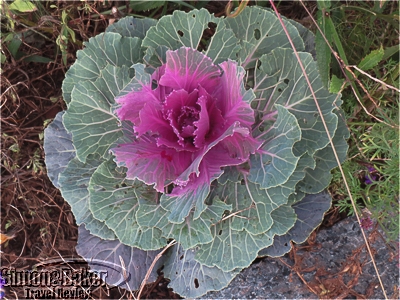
We liked the colorful plants visible along the walkways
The Inn by the Sea was active in habitat restoration. The property worked with the Maine Department of Conservation and Bureau of Parks and Land to restore habitat for the endangered New England cottontail rabbit at Crescent Beach State Park. In an effort to stop the New England cottontail from vanishing in Maine, as it had in the rest of New England, the Inn removed two acres of invasive, non indigenous plant species such as bamboo and bittersweet from state property. The Inn replanted the area with indigenous shrubs such as raspberry, blueberry, dogwood, alder, winterberry and dewberry to create a high quality, safe habitat for New England cottontails. The rabbits were named as candidates for the United States Endangered Species Act in 2006, and were listed as endangered in Maine and New Hampshire.























































